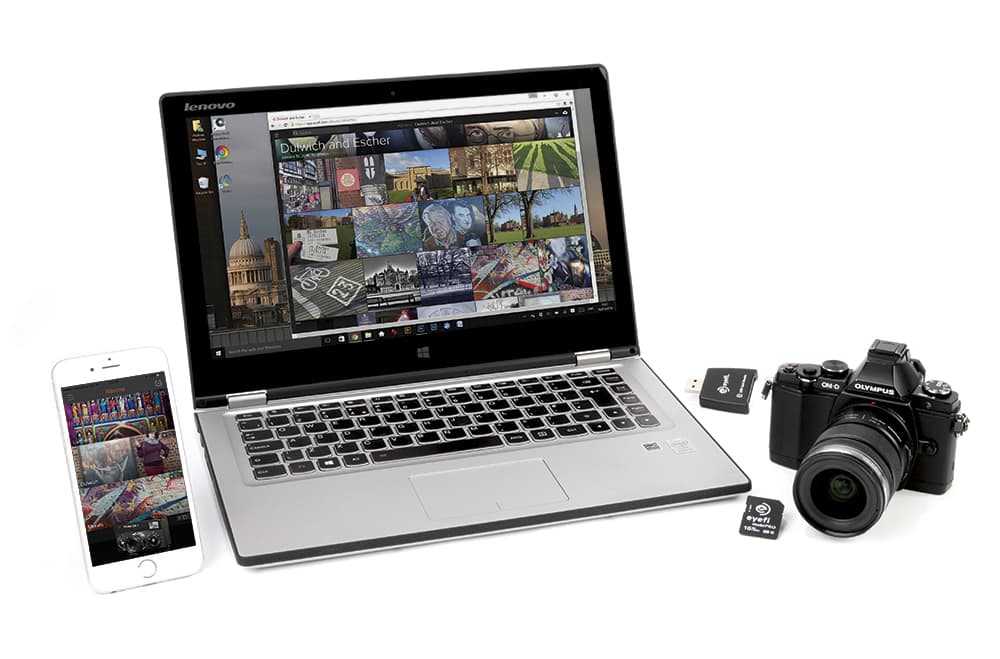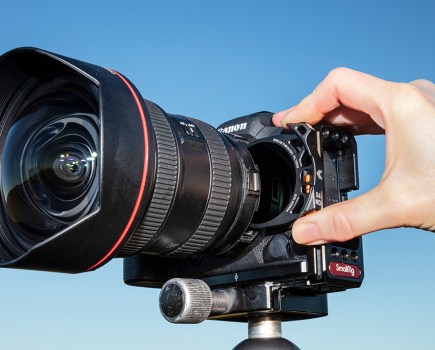
Eyefi’s Mobi Pro card can be used to transfer files wirelessly to computers or mobile devices
Data specifications
- Price: £49.99 (16GB) or £65.99 (32GB)
- Website: www.eyefi.com
- SDHC: Class 10 card with built-in Wi-Fi
- 16GB or 32GB capacity
- Supports wireless transfer of JPEG, raw and video files
- 1-year subscription to Eyefi Cloud storage service included
- Eyefi Mobi app available for most devices
- Desktop software available for Mac and Windows PC
Eyefi pioneered the concept of Wi-Fi-enabled SD cards, and has been making them for more than eight years now. However, with almost every new camera these days featuring built-in Wi-Fi, it might seem odd for the firm to be introducing a new-generation card. But think again – not only are there a huge number of non-Wi-Fi-enabled cameras in regular use, but Mobi Pro also offers features that simply aren’t available using cameras’ built-in Wi-Fi.
Most other set-ups are designed to allow you to pull selected pictures off your camera onto a smartphone or tablet for sharing with your friends and family. In contrast, Eyefi Mobi Pro is designed to automatically push everything you shoot to your smartphone, tablet or computer, and then upload it all to the Eyefi Cloud service, which gives unlimited cloud back-up for all your images. The card is also capable of connecting to a desktop computer using a home or studio Wi-Fi network. Together, this makes it the most interesting version yet for serious users.
Eyefi Mobi Pro is also quite configurable, so you can choose which features you’d like to use. It’s possible to transfer only selected images to your phone, or just JPEGs rather than raw files. You can therefore use it to transfer raw files automatically to your computer as you shoot, or just copy the odd JPEG to your phone for sharing on social media.
Setting up
Open the box and you’ll find the Wi-Fi SD card, a USB card reader and an activation code for a year’s subscription to Eyefi Cloud. To make full use of the card’s features you’ll need to continue this subscription at an annual cost of £34.99. The card reader is a nice touch, but not essential: I found that Mobi Pro worked quite happily in most other card readers too.
Initial set-up is anything but intuitive, not helped by the complete lack of documentation in the package (instructions are available on the support section of Eyefi’s website, and from the mobile app). You need to pair the card with your Mac or PC using the Eyefi Mobi Desktop app, and with each mobile device that you’ll be connecting it to via the free Eyefi Mobi app. This is available for an admirably wide range of devices, not just iOS and Android, but also Windows phones and Amazon Fire tablets. The card will only connect to one device at a time, though, so can’t transfer files to your phone and computer simultaneously. To configure options such as raw transfer, you need to connect the card directly to your computer.
In use
Once the card is set up, simply pop it in your camera and start shooting. If you’ve set the card to transfer files selectively, then marking an image as ‘protected’ will trigger transfer. One neat touch is that you can tell the Eyefi Mobi app to use your phone’s GPS to track your location while you’re out shooting, and then use this to geotag your images.
In terms of speed, I found the Mobi Pro performed very respectably. Testing it alongside a number of similarly specified 16GB SDHC Class 10 cards in my Olympus OM-D E-M5, it sat towards the top of the pack for write speed. The Wi-Fi has some impact on the camera’s battery life, of course, but it seems fairly minor. Overall, you don’t pay a significant performance penalty while shooting compared to conventional cards.
Unsurprisingly, though, wireless file transfer isn’t so fast. It took around ten seconds to copy each of my E-M5’s fine-quality 6MP JPEGs (typically 8MB in size) to my smartphone or tablet, and 15-20 seconds for raw files (around 16MB). So if you shoot a series of pictures in quick succession, a backlog can rapidly build up. This means you can’t necessarily rely on Mobi Pro for real-time feedback, so it’s not a direct substitute for tethered studio shooting.
By default, while you’re shooting, the card will automatically transfer every image you take to whichever device it’s currently connected to. It’s possible to set it up to copy JPEGs to your phone or tablet while you’re out shooting, then copy the corresponding raw files to your computer when you get home for upload to Eyefi Cloud. However, there’s no way of telling it not to transfer specific images, or prioritise your favourites, so you just have to let it do its own thing and wait patiently until it’s finished.
UPDATE – Eyefi tells us that it’s possible to prioritise images for immediate transfer using the camera’s ‘Protect’ feature, in a similar fashion to using selective transfer.
Frustratingly, it’s not possible to switch the card to selective transfer using the mobile app, so you can’t change modes if you’re out shooting and just want to copy one or two pictures to your phone. Oddly, you can’t wirelessly transfer the same image from your camera more than once, to both your phone and tablet, for example, or to restore an image
that you’ve accidentally deleted.

The Eyefi Mobi mobile app allows photos to be viewed on your phone by date taken, or sorted into albums for sharing with your friends and family
Eyefi Cloud
The next stage is syncing files to Eyefi Cloud, which the Mobi app will do fully automatically. If you want to preserve your data allowance, you can tell it to use a Wi-Fi connection only. In my experience the process was reliable, if not necessarily always very fast, although naturally this will be entirely dependent upon your network. Using the Mobi app you can also arrange your images into albums and share them. Hidden away in the Android version is an option to pause upload while you’re sorting and editing albums; I found this really useful, and just wish it were more accessible.
Everything gets synced across your devices, so you can create an album on your phone and then view it on your tablet. Unlike with online photo album services such as Flickr, all your images are copied at reduced size to each device for offline viewing. You can also browse and edit your albums on any computer using Eyefi’s web app (app.eyefi.com).
Eyefi Cloud acts as unlimited back-up for everything you shoot – not just JPEGs and movies, but raw too. This helps protect your precious photos from mishaps such as hard-drive failure. Of course, you could equally well use any other cloud storage service such as DropBox, but the advantage of Eyefi Cloud is its integration into the shooting process.
Your Eyefi Cloud account isn’t just limited to shots recorded onto the Mobi Pro card, either. You can also automatically copy across images shot using your phone’s camera, or upload any JPEG or raw file from your computer, meaning you can store JPEGs of your processed raw files. You only need one subscription no matter how many cards you’re using, too.
Eyefi Mobi camera compatibility
While Mobi Pro is compatible with most cameras that take SD cards, it’s best to check on the Eyefi website that it will work with your own (www.eyefi.com/cameras). Some models offer full support for Eyefi, including optimised power management and the ability to turn Wi-Fi on and off from the camera’s menus. Meanwhile, with others it’s necessary to tune power settings yourself, to ensure your camera doesn’t power itself off in the middle of a Wi-Fi transfer.
Mobi Pro cards will also work in some cameras that use CompactFlash cards via an Eyefi-certified adapter, which costs £15.99. This has the thicker CF Type II form factor, so it won’t fit every model, but again you can check on the Eyefi website.

Eyefi’s CompactFlash adapter allows use in a wide range of cameras
Our verdict
Eyefi Mobi Pro is, in effect, three distinctly different but linked products: the Wi-Fi card itself, the Eyefi cloud service and the Mobi app that bridges them. I used the system with several cameras (Olympus XZ-2, OM-D E-M5 and OM-D E-M5 II; Panasonic Lumix DMC-GM1 and Canon EOS 50D using a CF adapter) and devices of various vintages (Apple iPhone 4S, Samsung Galaxy Tab tablet and my laptop running Windows 10) and found that it did pretty much what it promised seamlessly and reliably, if not always quickly. But if you just want to copy the odd file across to your phone for sharing, Transcend’s Wi-Fi SD is a simpler and cheaper solution (£30 for a 16GB card).
Personally, I often found myself frustrated by Eyefi’s forced automation of the whole process, and the lack of user intervention available. I’d prefer to have more control in the Mobi app over what files go where and when. Hopefully, Eyefi can implement this in future versions of the app.
Overall, though, Mobi Pro offers a unique combination of features, and implements them pretty well. It won’t suit everyone’s workflow, but if you can see it fitting into yours, it’s an easy product to recommend.








